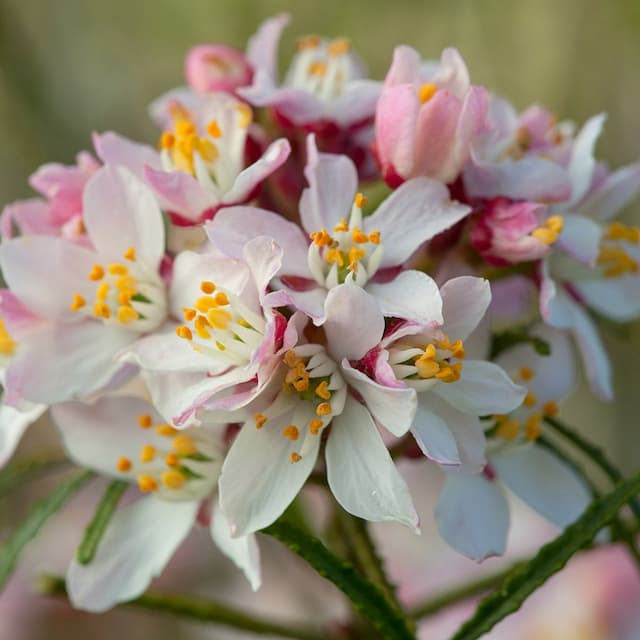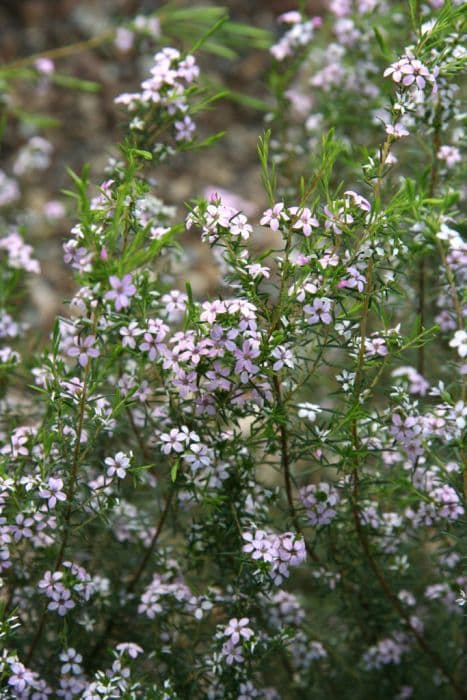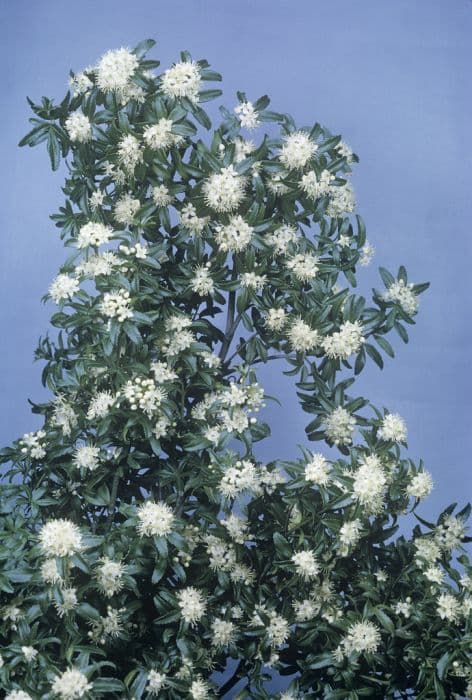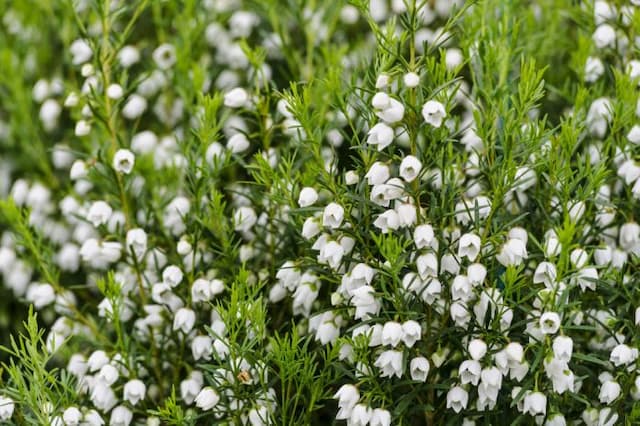Mexican orange 'Aztec Gold' Choisya × dewitteana 'Aztec Gold' (PBR)

ABOUT
'Aztec Gold' is a free-flowering, bushy, evergreen shrub. The aromatic leaves, with three to five slender leaflets, open yellow, maturing to green. Clusters of fragrant, white flowers appear in late spring and again in late summer to autumn
About this plant
 Names
NamesFamily
Rutaceae
Synonyms
Mexican Orange 'Aztec Gold', Aztec Gold Mexican Orange, Aztec Gold Choisya
Common names
Choisya × dewitteana 'Aztec Gold' (PBR).
 Characteristics
CharacteristicsLife cycle
Perennials
Foliage type
Evergreen
Color of leaves
Golden
Flower color
White
Height
6 feet (1.8 meters)
Spread
6 feet (1.8 meters)
Plant type
Shrub
Hardiness zones
7
Native area
Mexico
Benefits
 General Benefits
General Benefits- Ornamental Appeal: Features vivid golden-yellow foliage and fragrant white flowers, enhancing the visual aesthetics of gardens and landscapes.
- Drought Tolerance: Once established, it is relatively drought-tolerant, making it suitable for drier climates or water-wise gardens.
- Low Maintenance: Requires minimal care once established, ideal for gardeners seeking low-maintenance landscaping options.
- Pest Resistance: Generally resistant to common pests, reducing the need for chemical interventions.
- Year-Round Interest: Offers year-round interest thanks to its evergreen foliage, providing color and structure even in winter months.
- Adaptable Growth: Can be grown in a variety of soil types, as long as there is good drainage.
- Versatile Landscaping: Suitable for use in mixed borders, as a specimen plant, or for creating informal hedging.
- Compact Size: With a moderate growth habit, it is well-suited to smaller gardens and spaces where a compact shrub is desired.
- Attracts Wildlife: Flowers can attract pollinators like bees, bringing beneficial wildlife to the garden.
 Medical Properties
Medical PropertiesThis plant is not used for medical purposes.
 Air-purifying Qualities
Air-purifying QualitiesThis plant is not specifically known for air purifying qualities.
 Other Uses
Other Uses- Photography backdrop - The vibrant yellow-green foliage of the Aztec Gold Mexican Orange offers a bright and lush background for close-up nature photography.
- Visual barrier - When planted in a row, these shrubs can create a semi-impenetrable visual barrier, maintaining privacy in a garden or outdoor space.
- Educational resource - Horticulture students and gardening enthusiasts can use Aztec Gold Mexican Orange as a case study to learn about plant breeding and hybrid vigor.
- Culinary decoration - The branches and leaves could be used to add a touch of greenery to buffet tables or as plate decorations in culinary settings, although they are not edible.
- Insect habitat - The dense foliage can provide a habitat for beneficial garden insects, including pollinators like bees and butterflies.
- Natural dye - The leaves may be used in crafting natural dyes for textiles, although it's a more experimental use and color yield may vary.
- Artistic inspiration - The striking gold foliage and white blossoms of the plant serve as inspiration for artists and can be incorporated into paintings and illustrations.
- Seasonal decor - Cuttings from the Aztec Gold Mexican Orange can be used in fall and winter decor, offering a bright contrast to traditional autumnal tones.
- Garden themes - They can be used in thematic garden designs, such as a gold-themed garden, due to their distinctive leaf color.
- Sound barrier - The plants can muffle noise when used as hedging along the perimeter of a property, creating a more serene garden environment.
Interesting Facts
 Feng Shui
Feng ShuiMexican Orange Blossom is not used in Feng Shui practice.
 Zodiac Sign Compitability
Zodiac Sign CompitabilityMexican Orange Blossom is not used in astrology practice.
 Plant Symbolism
Plant Symbolism- Resilience: 'Aztec Gold' is a plant that thrives with minimal care once established, symbolizing the capacity to withstand challenges and recover quickly.
- Prosperity: The common name 'Aztec' refers to the rich and powerful civilization, and 'Gold' suggests wealth, hence this plant is often associated with abundance and prosperity.
- Warmth: The golden color of the foliage represents the warmth of the sun, evoking a sense of comfort and positivity.
- Optimism: The vibrant yellow-green leaves can symbolize optimism and a positive outlook, much like the brightness of a new day.
 Water
WaterMexican Orange 'Aztec Gold' thrives when watered deeply but infrequently, allowing the soil to dry out slightly between waterings. Typically, watering once a week is sufficient, but this may need to increase to twice per week during prolonged dry spells or hot weather. Aim to provide about 1 to 1.5 gallons of water per plant for each watering, adjusting as needed for the size of the plant and the prevailing weather conditions. During winter, water less frequently, only ensuring that the root ball does not dry out completely.
 Light
LightMexican Orange 'Aztec Gold' prefers a spot that receives full sun to partial shade. Ideal locations provide morning sunlight and afternoon shade, especially in hotter climates. However, the plant is adaptable and can also do well in a lightly shaded area where it receives dappled sunlight throughout the day.
 Temperature
TemperatureMexican Orange 'Aztec Gold' is hardy and can tolerate a range of temperatures, but ideally, it should be grown in conditions where the temperature remains between 50°F and 80°F. The plant can survive brief periods of cold down to about 15°F, but extended exposure to temperatures below 20°F may cause damage. The ideal growing conditions are temperate, avoiding the extremes of both heat and frost.
 Pruning
PruningPrune Mexican Orange 'Aztec Gold' to maintain its shape and encourage bushier growth. The best time to prune is after the plant has finished flowering in late spring or early summer. Cut back any overgrown branches or stems, and remove any dead or damaged wood. Pruning can be done annually, but avoid heavy pruning; instead, trim lightly to shape the plant.
 Cleaning
CleaningAs needed
 Soil
SoilMexican Orange Blossom, or Choisya 'Aztec Gold', thrives in a well-draining soil mix with a pH of 6.0-7.5. An ideal mix contains loamy soil, peat, and coarse sand or perlite to ensure adequate drainage and aeration. Enriching the soil with organic matter like compost will also promote healthy growth.
 Repotting
RepottingMexican Orange Blossom typically needs repotting every 2-3 years. Young plants grow more rapidly and may require annual repotting, while mature, established shrubs need less frequent repotting.
 Humidity & Misting
Humidity & MistingMexican Orange Blossom prefers moderate humidity levels. It is adaptable to outdoor humidity conditions and does not typically require additional humidity when grown indoors.
 Suitable locations
Suitable locationsIndoor
Provide bright, indirect light and well-draining soil.
Outdoor
Plant in sunny to partially shaded area with well-draining soil.
Hardiness zone
7-10 USDA
 Life cycle
Life cycleChoisya × dewitteana 'Aztec Gold', commonly known as Mexican Orange 'Aztec Gold', starts its life cycle when its seeds germinate in spring under the appropriate temperature and soil conditions. The seedlings develop into juvenile plants with characteristic golden-yellow foliage, which gradually mature during the growing season. During maturity, the plant reaches its full size and shape, producing clusters of fragrant white flowers that typically bloom in late spring or early summer, with a potential second flowering in autumn. After pollination, the flowers may produce small, inedible fruits containing seeds that can be dispersed to start a new generation. Throughout its life, the plant undergoes seasonal growth and dormancy cycles, where active growth occurs in warm seasons and the plant enters a dormant state during colder, winter months. With proper care, the Mexican Orange 'Aztec Gold' can live for many years, creating a woody structural base from which new growth emerges annually.
 Propogation
PropogationPropogation time
Spring-Early Summer
Choisya × dewitteana 'Aztec Gold,' also known as Mexican Orange, is commonly propagated through the process of semi-hardwood cuttings. This method is often carried out in late summer. To do this, a gardener will select a healthy, non-flowering shoot and cut a section approximately 4 to 6 inches (10 to 15 cm) long. The lower leaves are removed, and the cut end is dipped into a rooting hormone to encourage root growth. The cutting is then placed in a well-drained potting mix and kept in a warm, humid environment, often under a plastic cover to retain moisture. Rooting typically takes a few weeks, after which the new plant can be potted on and gradually acclimatized to outdoor conditions.








![Mexican orange [Sundance]](/_next/image?url=https%3A%2F%2Fplants-admin.emdemapps.com%2Fimages%2Fplants%2F%2Fimages%2F604b5381bcf0d.png&w=640&q=75)
